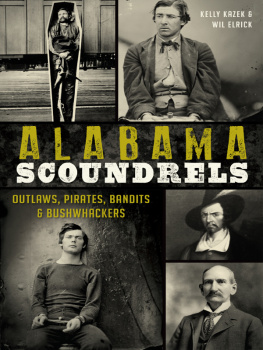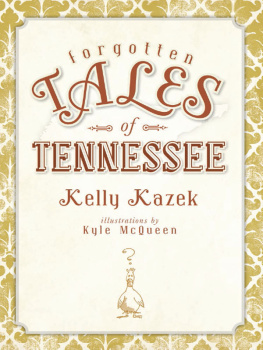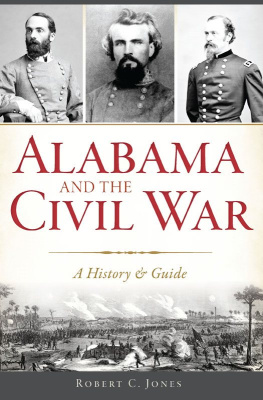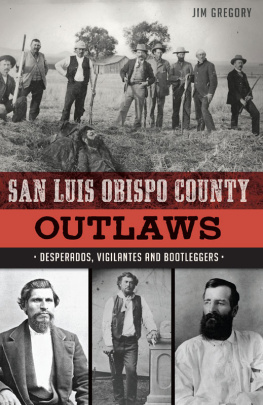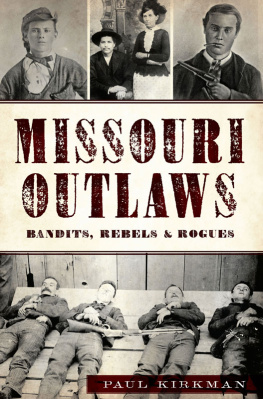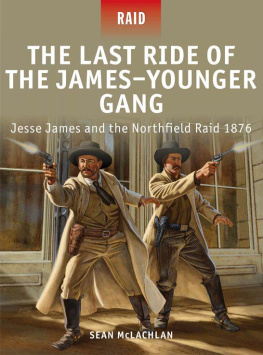

Published by The History Press
Charleston, SC 29403
www.historypress.net
Copyright 2014 by Kelly Kazek and William Elrick
All rights reserved
First published 2014
e-book edition 2014
ISBN 978.1.62585.067.6
Library of Congress Cataloging-in-Publication Data
Kazek, Kelly.
Alabama scoundrels : outlaws, pirates, bandits & bushwhackers / Kelly Kazek and William Elrick.
pages cm. -- (True crime)
ISBN 978-1-62619-533-2 (paperback)
1. Criminals--Alabama--History. 2. Outlaws--Alabama--History. 3. Crime--Alabama--History. I. Title.
HV6793.A2K39 2014
364.10922761--dc23
2014018003
Notice: The information in this book is true and complete to the best of our knowledge. It is offered without guarantee on the part of the author or The History Press. The author and The History Press disclaim all liability in connection with the use of this book.
All rights reserved. No part of this book may be reproduced or transmitted in any form whatsoever without prior written permission from the publisher except in the case of brief quotations embodied in critical articles and reviews.
To the adventures that have brought me to this point in life and, more so, to the adventures that will take me into tomorrow.
Wil Elrick
To my kidsShannon, Zane and Ezra.
Kelly Kazek
CONTENTS
INTRODUCTION
When you hear the word outlaw, most of the time, your mind will jump to the Wild West of the late 1800s plainsthe men with bandanas pulled over their faces robbing a stagecoach or hijacking a train, the brazen bank robberies that took place in newly settled towns and the high-noon showdown between the outlaw gunman and the local sheriff. But these images from television, movies and books only show the surface of the outlaw existence.
In the first half century of our countrys existence, Alabama was considered the Wild West as settlers embraced Manifest Destiny and moved farther from the East Coast and our founding settlements. The land was harsh, the settlements were scattered and people had to be tough to survive. It was a perfect setting for lawlessness.
The people who began settling the state in the early 1800s were hardy, resourceful and fearless. The only law most settlers lived by was that of the land, and it was every family for itself until settlers began to gather in communities.
With statehood in 1819 came more people, laws, businesses, towns and, of course, trouble. With each community came men who wanted to steal or cause destruction. We call these men outlaws, scoundrels, bushwhackers or any number of colorful names, but one thing remains constant: they used violence to accomplish their goals.
As communities formed, more laws were created, and peace officers were needed to enforce them. Oftentimes, those charged with enforcing the governmental laws walked a thin line between criminal and lawman. It was not unusual for a man considered an outlaw in one community to be found as a sheriff or constable in another.
Alabama Scoundrels: Outlaws, Pirates, Bandits & Bushwhackers brings to life more than two dozen of the most infamous lawbreakers to set foot on Alabama soil. The lives of these men span our history starting in the early eighteenth century when pirates sailed our coastal waters, followed by the nineteenth century when law and order began to rule the day and ending in the twentieth century when the Industrial Revolution helped develop a more orderly society.
The crimes these scoundrels were accused of committing vary as widely as the personalities of the men themselves. You will find tales of the pirate Jean Lafitte, Civil Warera bushwhackers Colonel Joseph Sanders and Milus Johnston, Lincoln assassination conspirator Lewis Powell, social activist turned anarchist Albert Parsons, one-time vice president Aaron Burr, cult leader turned murderer Bloody Bob Sims and the mysterious hobo outlaw Railroad Bill.
From their starts to their finishes, the lives of well-known gunslingers with ties to the state are also described on these pages, including John Wesley Hardin, outlaw Tom Clark, Rube Burrow, James Copeland, outlaw sheriff Steve Renfroe, Bart Thrasher and two of the most widely known outlaws in our nations history, Frank and Jesse James.
WHAT MAKES AN OUTLAW?
The term outlaw dates as far back as ancient Rome as a legal concept. The word meant outside the protection of the law, which, in effect, gave permission for vigilante justice. In ancient times, citizens were legally empowered to kill anyone who was designated an outlaw. In the early days of settling Alabama, vigilante justice was not legally recognized, although it was often given taciturn approval.
Historians list numerous factors that made the nineteenth century the perfect time for breeding outlaws, including sparse populations with easy hiding places, fewer banks so that citizens carried their valuables with them when they traveled and the harsh realities of a time when people were struggling merely to survive. Upheaval from the Civil War and Reconstruction also bred many outlaws.
In the newly formed territories and states, tracking criminals across vast and wild lands was treacherous and time consuming. Some of the outlaws in this book managed to outsmart justice, disappearing into history with their dates and places of death unknown, but many more faced violent ends, often at the end of a hangmans noose or a gun barrel.
BECOMING ALABAMA
Famed Spanish explorer Hernando De Soto initially entered what would become Alabama in 1539, but it would be more than 160 years before the area was settled.
In the eighteenth century, coastal areas of the state were popular sites for settling because of the reliance on sea travel. Dauphin Island, initially known as Massacre Island, was settled by French explorer Pierre Le Moyne dIberville in 1699, while other areas that now make up Baldwin and Mobile Counties were part of Spanish West Florida in 1783, the Republic of West Florida in 1810 and the Mississippi Territory in 1812.
Much of what is now northern Alabama was initially considered part of the Yazoo lands and then, after 1767, was under the province of Georgia during colonization by the British through the Revolutionary War. The lower third of Alabama became part of the Mississippi Territory in 1798, with the Yazoo lands added to the territory in 1804.
Before Mississippi was admitted to the United States of America in 1817, the eastern portion of the Mississippi Territory was split off and named the Alabama Territory. St. Stephens, now defunct, was Alabamas territorial capital. The Alabama Territory was granted statehood in 1819.
Later that year, the U.S. Congress selected Huntsville as the site of the states first Constitutional Convention, and the north Alabama city served as the temporary capital of Alabama until 1820.
Capitals in Alabama were:
Huntsville in Madison County, 181920
Cahaba in Dallas County (now a ghost town), 182025
Tuscaloosa in Tuscaloosa County, 182646
Montgomery in Montgomery County, 1847present
The first capital building in Montgomery was built in 1847 but burned in 1849. It was replaced with the existing building in 1851.
During this time when legislators were organizing the state of Alabama and writing its laws, some of its citizens were doing their best to break them and escape the states justice.
CHAPTER 1
BLOODY BOB SIMS
Next page
